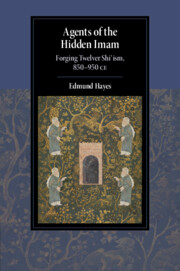Book contents
- Agents of the Hidden Imam
- Cambridge Studies in Islamic Civilization
- Agents of the Hidden Imam
- Copyright page
- Dedication
- Epigraph
- Contents
- Figures
- Tables
- Acknowledgments
- Abbreviations
- Introduction
- 1 The Rise of the Agents in the Late Imamate (830–874 ce)
- 2 The Crisis before the Crisis
- 3 Crisis!
- 4 The Agents of the Nāḥiya in the Era of Perplexity
- 5 The Creation of an Envoy
- 6 Rise and Fall
- Conclusion
- Bibliography
- Index
- Other titles in the series
- References
Bibliography
Published online by Cambridge University Press: 13 January 2022
- Agents of the Hidden Imam
- Cambridge Studies in Islamic Civilization
- Agents of the Hidden Imam
- Copyright page
- Dedication
- Epigraph
- Contents
- Figures
- Tables
- Acknowledgments
- Abbreviations
- Introduction
- 1 The Rise of the Agents in the Late Imamate (830–874 ce)
- 2 The Crisis before the Crisis
- 3 Crisis!
- 4 The Agents of the Nāḥiya in the Era of Perplexity
- 5 The Creation of an Envoy
- 6 Rise and Fall
- Conclusion
- Bibliography
- Index
- Other titles in the series
- References
Summary

- Type
- Chapter
- Information
- Agents of the Hidden ImamForging Twelver Shi‘ism, 850-950 CE, pp. 222 - 241Publisher: Cambridge University PressPrint publication year: 2022

